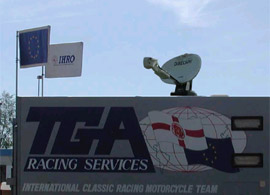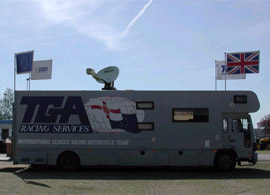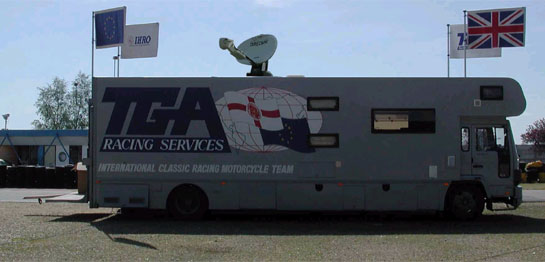
Racing
Services
Vehicles

UK
|

 

As part of their commitment to
excellence, the TGA Racing Services team recently acquired an
iNetVu system for their new 45-foot support vehicle. This unique
support truck serves as an additional tow vehicle, mobile workshop,
storage, office, and crew lounge. Currently the support truck is
being equipped and outfitted and will debut at the end of this
month. The vehicle is an excellent fit in supporting the team's
championship goals. In addition, it serves as a large, rolling
billboard to provide greater exposure for sponsors and business
partners.
Even now during the outfitting process, it has drawn much attention
locally. Watch for iNetVu Mobile High-Speed Satellite Internet
systems on more racing support service vehicles on a highway or race
site near you.
In the world of NASCAR where last minute technical adjustments can make the difference
between taking the checkered flag and spending the day making repairs on pit row, high-speed
network communications are critical. The 40+ week NASCAR schedule is a 10-month road trip
where cars need to be repaired, performance monitored and dynamic management decisions
made from remote locations, away from the “home” garages of NASCAR teams.
The days of exchanging faxes and FedExes are no longer viable for racing teams, as decisions
need to be made rapidly -- especially on race day. However, virtually no NASCAR tracks are
equipped with flexible, affordable high-speed broadband Internet access and the onus is put on
each racing team to develop a communications strategy.
Hendrick Motorsports (HMS) is one of the most successful racing teams in NASCAR with its team
members including Jeff Gordon and Terry Labonte – who have six Winston Cup Series point
championships combined -- as well as Brian Vickers, the reigning Busch Series champion. HMS,
which owns four cars on NASCAR’s Nextel Cup circuit and numerous cars in the Busch Series,
needed to find a reliable, robust and most importantly, portable communications solution to
support its large mobile operations— one which could quickly be deployed and taken down on a
weekly basis.
After evaluating several
solutions, HMS selected
Tachyon Networks
Incorporated’s (“Tachyon”)
broadband satellite solution.
HMS was no stranger to
criticisms of broadband satellite
technologies, as the team
previously used a VSAT provider
that could only provide low
bandwidth, insecure Internet
access for e-mail and Web
browsing. The team was
skeptical and required Tachyon
to guarantee its network
performance with a service level
agreement.
Utilizing a satellite dish and a
secure communications network built on a suite of patented TCP/IP compliant technologies,
Tachyon provides HMS with an uplink speed of 512 Mbps and a 1.5Mbps downlink, which
supports its entire onsite crew at every event.
NASCAR may not be rocket science but it is pretty close. Horsepower, aerodynamics, tire
pressure, tire treads, fuel efficiency and many other factors can cause a tenth of a second
difference and poor pole positions or, even worse, a crash. Even changes in barometric pressure
and humidity can alter a team’s race strategy and require major adjustments to a car.
HMS leverages Tachyon to obtain mission critical information on race day, allowing the team to
anticipate rain delays or changes in track conditions using SQL based applications, MS
Exchange. The ability to predict weather that will occur in as little as five or 10 minutes placed
HMS in a competitive advantage in several races as it was able to delay pit stops until the rains
came, allowing its race cars to make up time on other teams that did not have up-to-date weather
intelligence.
The First Thing: Broadband Connectivity
After HMS’s caravan of race crews and equipment arrives at a track, the first order of business is
setting up the Tachyon broadband satellite network. Within 20 minutes, HMS engineers usually
have the network up and running. Integrating products from Proxim®, Omni® and Motorola®,
Tachyon is also the centerpiece of Hendrick’s innovative 802.11 secure Wi-Fi network that is set
up and dismantled every six days.
To judge the Tachyon broadband network by its performance on Sunday race days alone would
be missing the weekly preparations enabled by the Tachyon network. NASCAR crews put their
cars through a labyrinth of technical tests every day and require the ability to evaluate test results
and work with technical teams back at headquarters to assess repairs and adjustments for each
car. Car repair and engineering manuals are measured in pounds, not pages. Tachyon allows
HMS racetrack technicians to access critical technical data from the company’s corporate
network in a highly secure and efficient manner, speeding repair times and allowing drivers to
spend more time testing their cars and less time waiting on the sidelines.
“Tracks don’t have dial tones, let alone
broadband access in the garage areas,
and we need to get into our corporate
network multiple times during the day,”
said Chris Newsome, director of IT at
HMS. “We utilize Tachyon to rapidly
access critical information, through an
integrated, highly secure network
environment. Without the Tachyon
transportable broadband network
connection, we would still have enough
knowledge to get the cars ready to race,
but we would not be prepared for
crisis/disaster recovery situations, or
have information-based dynamic
decision making capabilities.”
In today’s Internet age, HMS is leveraging Tachyon’s portable broadband satellite to achieve a
competitive advantage and bring all the comforts of the “home” LAN on the road from Daytona to
Dover and Talladega to Texas. In an industry where the fastest and most dependable cars win,
the top teams are requiring the same attributes from their communications networks.
During the 2004 season, HMS will continue to leverage satellite communications for competitive
advantage. The team is deploying a Mobile Communications Truck designed to carry four cars
for Gordon and Johnson to scheduled track testing. Leveraging HMS’s wireless data network and the Tachyon Auto Deploy satellite network, HMS will now have network connectivity during
both testing and racing days.
Prior to even starting their engines, the 24 and 48 cars will already have a lead on their nearest
competition.
|




